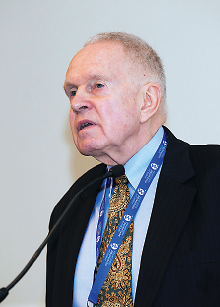HHS Issues Rule to Expand Access to Office-Based Buprenorphine Treatment
Abstract
An IPS session focuses on new federal regulations that allow practitioners to attain a waiver to prescribe buprenorphine to 275 patients with opioid use disorders.
A final rule issued by the Department of Health and Human Services and its Substance Abuse and Mental Health Services Administration (SAMHSA) represents a major step to increase access to buprenorphine treatment by individuals with opioid-related disorders, according to speakers last month at APA’s fall conference, IPS: The Mental Health Services Conference, in Washington, D.C.

John A Renner Jr., M.D., says that the monitoring requirements for buprenorphine treatment are now more stringent.
“The year 2016 has been a very significant year as it relates to regulatory changes for buprenorphine treatment for opioid use,” John A. Renner Jr., M.D., a professor of psychiatry at Boston University School of Medicine and vice chair of APA’s Council on Addiction Psychiatry, said.
The rule allows practitioners who have a waiver to prescribe buprenorphine for up to 100 patients a year to obtain a waiver to treat up to 275 patients. The rule went into effect August 8.
The rule requires that physicians be board certified in addiction medicine or addiction psychiatry from a specialty medical board and/or professional society. Physicians who do not have such certification must practice in a qualified setting and are required to have the following:
Access to 24-hour emergency services and case management services.
Utilization of health information technology.
Registration with the state prescription drug monitoring program.
Acceptance of third-party payments for at least some of its services.
What to Know Before Prescribing Buprenorphine Subdermal Implant
Several efforts have been made this year to increase access to buprenorphine treatment for opioid use disorders, including the Food and Drug Administration (FDA) approval of Probuphine, the first buprenorphine implant for the maintenance treatment of opioid dependence. For psychiatrists who wanted to know—in a nutshell—about Probuphine, a session at this year’s IPS: The Mental Health Services Conference included an overview of the implantable device and FDA requirements for prescribing probuphine (brand name ProNeura, manufactured by Titan Pharmaceuticals).
Probuphine consists of four, one-inch-long rods that are implanted under the skin on the inside of the upper arm and provide treatment for six months.
The medication is designed to be surgically placed under the skin inside the upper arm to provide a constant, low-level dose of buprenorphine for six months in patients who are already stable on low-to-moderate doses of other forms of buprenorphine as part of a medication-assisted treatment program.
The medication must be prescribed and dispensed according to the Probuphine Risk Evaluation and Mitigation Strategy (REMS).
The medication must be inserted and removed only by a health care provider who has completed necessary surgical training and attained certification through Probuphine REMS.
Petros Levounis, M.D., M.A., co-chair of the IPS session and chair of the Department of Psychiatry at Rutgers New Jersey Medical School, said that once a patient initiates probuphine treatment with one prescriber, that patient is not allowed to switch probuphine prescribers within the six-month treatment period. Patients receiving probuphine will also be counted in the number for patients treated under a buprenorphine waiver, Levounis added.
Levounis also pointed out that prescribing psychiatrists and the surgeons inserting the medication are required to be associated in the same facility.
“The last requirement has a very clear intent to get rid of ‘pill mills,’ eliminating cash-only operations for buprenorphine,” said Renner.
To ensure that physicians are in compliance with safe and appropriate prescribing practices at the new treatment limit, SAMHSA has also implemented new reporting requirements. Practitioners must report the annual caseload of patients by month, the number of patients provided behavioral health services and referred to them, and features of the practitioner’s diversion control plan. According to Renner, a diversion monitoring control plan may include random urine checks, a set number of callbacks, or required counseling for a substance use disorder.
After practicing at the 100-patient level for a year, psychiatrists can apply to increase their patient limit to 275 using the Waiver Notification Form SMA-167. SAMHSA will review applications within 45 days of receipt and will notify applicants if they have been approved.
“It’s is not clear to me as of yet if we will have solved the problem of [increasing access to treatment for opioid use disorders] by increasing waiver limits,” Renner said. “Some research suggests that even though the limit to prescribe buprenorphine to patients is increasing, it may not equate to many physicians prescribing the drug to more patients. We will have to be cautious as we watch what happens next.” ■



